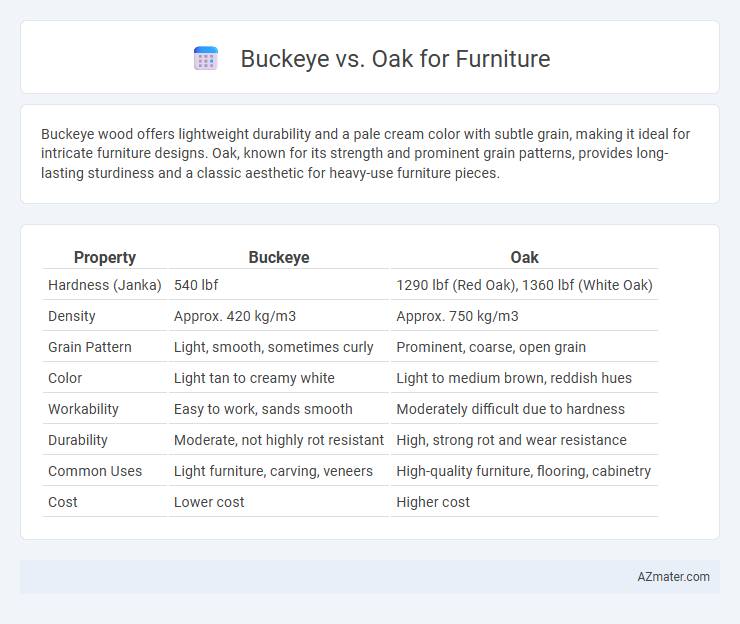Buckeye wood offers lightweight durability and a pale cream color with subtle grain, making it ideal for intricate furniture designs. Oak, known for its strength and prominent grain patterns, provides long-lasting sturdiness and a classic aesthetic for heavy-use furniture pieces.
Table of Comparison
| Property | Buckeye | Oak |
|---|---|---|
| Hardness (Janka) | 540 lbf | 1290 lbf (Red Oak), 1360 lbf (White Oak) |
| Density | Approx. 420 kg/m3 | Approx. 750 kg/m3 |
| Grain Pattern | Light, smooth, sometimes curly | Prominent, coarse, open grain |
| Color | Light tan to creamy white | Light to medium brown, reddish hues |
| Workability | Easy to work, sands smooth | Moderately difficult due to hardness |
| Durability | Moderate, not highly rot resistant | High, strong rot and wear resistance |
| Common Uses | Light furniture, carving, veneers | High-quality furniture, flooring, cabinetry |
| Cost | Lower cost | Higher cost |
Introduction to Buckeye and Oak Woods
Buckeye wood, derived from the Aesculus genus, is characterized by its pale, cream to light brown hue and soft texture, making it a favored choice for intricate carvings and lightweight furniture. Oak wood, predominantly sourced from Quercus species, is renowned for its durability, prominent grain patterns, and rich tones ranging from light beige to deep reddish-brown, offering robust strength ideal for heavy-use furniture. Both woods exhibit unique qualities that influence their applications in furniture design, with Buckeye favored for its workability and Oak prized for its longevity and distinctive aesthetics.
Key Characteristics of Buckeye Wood
Buckeye wood features a light cream to yellowish color with occasional darker brown streaks, offering a smooth texture that is easy to work with for furniture making. Its fine, straight grain and relatively low density provide moderate durability and a soft feel, making it suitable for indoor furniture pieces that prioritize aesthetic appeal over heavy wear resistance. Buckeye wood's stability and resistance to warping enhance its use in detailed cabinetry and decorative furniture elements, though it is less common than oak due to its softer, less robust nature.
Defining Features of Oak Wood
Oak wood is renowned for its prominent grain pattern and exceptional durability, making it a prime choice for high-quality furniture. It possesses a dense, hard texture with natural resistance to wear and decay, often featuring a warm, reddish-brown or light tan color. The wood's coarse texture combined with its ability to take stains and finishes evenly enhances its aesthetic appeal and longevity in furniture applications.
Durability Comparison: Buckeye vs Oak
Buckeye wood offers moderate durability with a Janka hardness rating of about 850, making it softer and less resistant to dents and scratches compared to oak. Oak, particularly red and white varieties, boasts a higher Janka hardness between 1290 and 1360, providing superior resilience and longevity for furniture. The dense grain structure of oak enhances its resistance to wear, making it a more durable choice for high-usage furniture pieces.
Aesthetic Differences: Grain and Color
Buckeye wood features a unique, irregular grain pattern with striking contrasts of dark streaks against a lighter background, creating a visually dynamic and rustic appearance. Oak wood is known for its prominent, straight grain and consistent texture, offering a classic, warm look with shades ranging from light tan to medium brown. While Buckeye presents a more dramatic and artistic aesthetic, Oak provides timeless elegance and uniformity ideal for traditional furniture designs.
Workability and Ease of Crafting
Buckeye wood is known for its exceptional workability due to its soft texture, making it easy to carve, shape, and sand, which is ideal for intricate furniture designs. Oak, on the other hand, is much harder and denser, requiring more effort and specialized tools to craft, but it provides superior durability and a classic grain pattern favored in furniture making. The choice between Buckeye and Oak largely depends on the desired balance between ease of crafting and long-term strength in furniture projects.
Cost and Availability Considerations
Buckeye wood is generally more affordable than oak, making it a cost-effective choice for budget-conscious furniture buyers. Oak, known for its durability and grain pattern, often commands a higher price due to its widespread use and demand in premium furniture markets. While oak is readily available in most lumber suppliers worldwide, buckeye can be harder to source, limiting its availability and potentially increasing lead times for furniture projects.
Suitability for Different Furniture Types
Buckeye wood, known for its lightweight and smooth texture, is ideal for delicate furniture pieces such as carved chairs and decorative items, offering ease in detailed craftsmanship. Oak, with its robust hardness and grain, suits heavy-use furniture like dining tables, cabinets, and flooring, providing durability and a classic appearance. Both woods vary in grain patterns and strength, making Buckeye preferable for ornamental uses while Oak excels in structural, high-traffic furniture applications.
Maintenance and Longevity
Buckeye wood offers low maintenance due to its natural resistance to decay and insect damage, making it ideal for indoor furniture with moderate use. Oak furniture, known for its exceptional durability and high density, requires regular cleaning and occasional sealing to maintain its longevity, especially in high-traffic areas. Both woods provide long-lasting furniture, but oak's hardness ensures greater resistance to dents and scratches over time.
Choosing the Right Wood: Buckeye or Oak?
Choosing the right wood for furniture depends on durability, grain appearance, and workability; oak offers exceptional hardness, resistance to wear, and a classic grain pattern ideal for long-lasting pieces. Buckeye, while softer and less dense, features a unique, lighter color with striking grain variations, making it perfect for decorative or lighter-use furniture. Consider oak for heavy-use and structural integrity, and buckeye for aesthetic appeal and intricate woodworking projects.

Infographic: Buckeye vs Oak for Furniture
 azmater.com
azmater.com